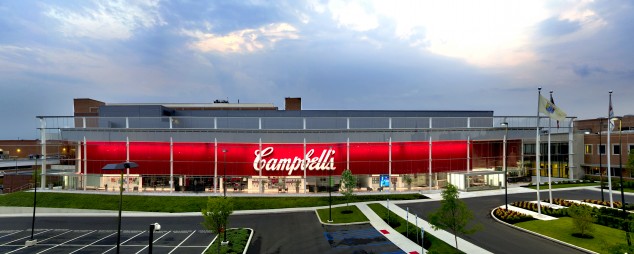
Campbell Outlines Four Promising Platforms to Drive Growth over the Next Decade
On Feb 22, 2017Campbell Soup Company President and Chief Executive Officer Denise Morrison and Senior Vice President and Chief Financial Officer Anthony DiSilvestro provided an overview of the Camden-based company’s strategic direction during the Consumer Analyst Group of New York (CAGNY) Conference in Boca Raton, Fla. today.
Morrison shared her perspective on the state of the food industry and the consumer environment, and highlighted the steps Campbell is taking to define the future of real food through strategic foresight.
Morrison said, “Across every industry and in every organization, the pace of change is unpredictable, unrelenting and unforgiving. The future food world will be more complex and more challenging. To fully unlock Campbell’s performance, we’re looking beyond typical five-year planning horizons and establishing well-informed perspectives on opportunities and disruptions driven by the intersection of real food, health and well-being and technology.”
Morrison focused on four emerging growth platforms, including:
- Future Commerce: E-commerce is transforming the food industry. Between 2016 and 2021, e-commerce sales of food and beverages are projected to reach $66 billion with a compound annual growth rate of 38 percent.1 Morrison painted a picture of frictionless future commerce where consumers’ food needs will be met anywhere, anytime through connected kitchens and an always-on shopping environment. Morrison outlined Campbell’s current programs and plans such as meal kits, buy-now capabilities, recipe integration with leading recipe sites, and dash buttons, as well as the company’s focus on increasing its e-commerce capabilities as consumer expectations shift from centralized locations and platforms to diverse omni-channel experiences.
- My.Moments: Campbell recognizes a growth opportunity to expand its business in snacking across many of its categories. Snacking is an $89 billion market in the U.S. with a compound annual growth rate of nearly 3 percent.2 While more than two-thirds of snacks are of the “mindless munching” variety, the snacks of tomorrow will be more deliberate with a specific purpose; they will be more accessible, affordable and high-quality; and they will be both customizable and offer functional benefits. Campbell’s longer-term plans include adding functional benefits to its existing snacks, while also selecting real food ingredients that can address specific needs, such as endurance, mood and energy management, with a goal of ultimately creating new snacking platforms that are true to the company’s Purpose, Real food that matters for life’s moments.
- Better.Me: The next frontier in nutrition will be about reconfiguring diets according to an individual’s specific physiology, lifestyle and health goals. The Better.Me growth platform leverages biometric data to provide personalized food options. To meet this emerging need, Campbell funded Habit, a new startup company positioned at the intersection of health, technology and food, poised to lead the personalized nutrition revolution. Habit is currently being tested in the Greater San Francisco area.
- Limitless Local: Limitless Local is a movement that embraces smaller, more regional farming and food production models that foster new narratives around quality, community and place. It fosters a more intimate relationship to food, where it comes from, how it’s made and who the people are behind it. Campbell is incorporating Limitless Local in its product development, with brands such as 1915 by Bolthouse Farms, Well Yes! soup, and Prego Farmers’ Market, as well as a small-batch production of one of the company’s original tomato soup recipes using local New Jersey beefsteak tomatoes. Campbell’s history of working with American family farmers for more than a century and its rich heritage of making simple, affordable and delicious foods uniquely position the company to leverage this growth platform.
“Guided by our Purpose and our strategic imperatives, we set out to identify clear and compelling growth opportunities. We prioritized these growth platforms we believe will have the greatest impact on Campbell and lead to significant growth opportunities over the next decade,” said Morrison. “We have what we need to meet the challenges of this new world. If you look closely at the 148-year history of Campbell, we are not only a company that has proven ourselves capable of dealing with profound change … we are a company with a history of leading profound change, and we are a company that has thrived in periods of profound change. I’m confident that we can and will do so again in the future.”
DiSilvestro provided an update on the company’s three divisions and its multi-year cost savings program, which has generated cost savings by reducing layers of management and increasing spans of control, creating an integrated global services organization and implementing zero-based budgeting. While Campbell’s current initiatives will generate in excess of $300 million in savings, the company has identified additional areas of savings opportunity, leading the company to increase its aggregate savings target to $450 million by the end of fiscal 2020. The company expects to achieve these additional savings by further optimizing its supply chain network, primarily in North America; evolving its operating model over time to focus resources on growth opportunities and drive additional efficiencies; and more fully integrating recent acquisitions to generate cost synergies and improve effectiveness by leveraging enterprise scale and capabilities. Cost savings to date have contributed to recent margin expansion and funded reinvestments in the business.
DiSilvestro said, “Our strategy is to reinvest a portion of these savings in order to drive growth. We’ll do this a number of ways including increasing marketing support on our key brands, funding new product launches and investing against our real food initiative; making investments in long-term innovation; focusing on geographic expansion in faster-growing spaces; and building our capabilities in digital and e-commerce.”
Related Articles:





